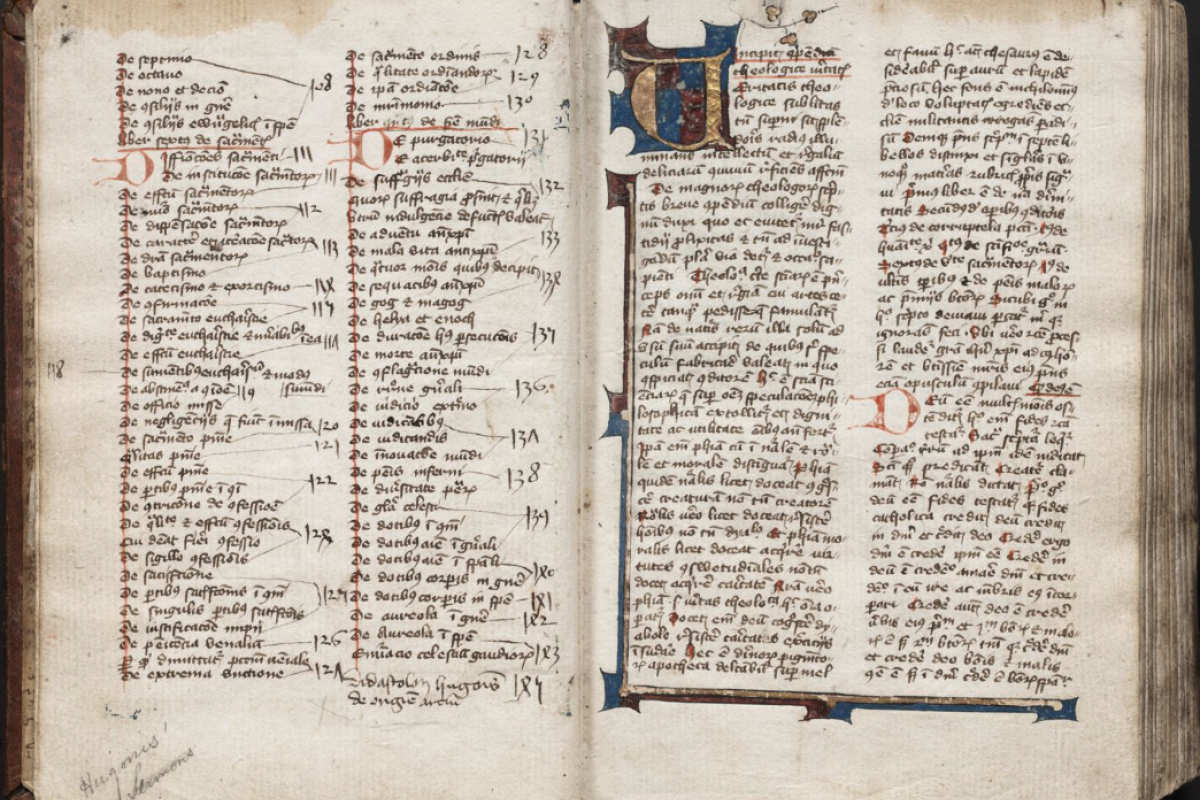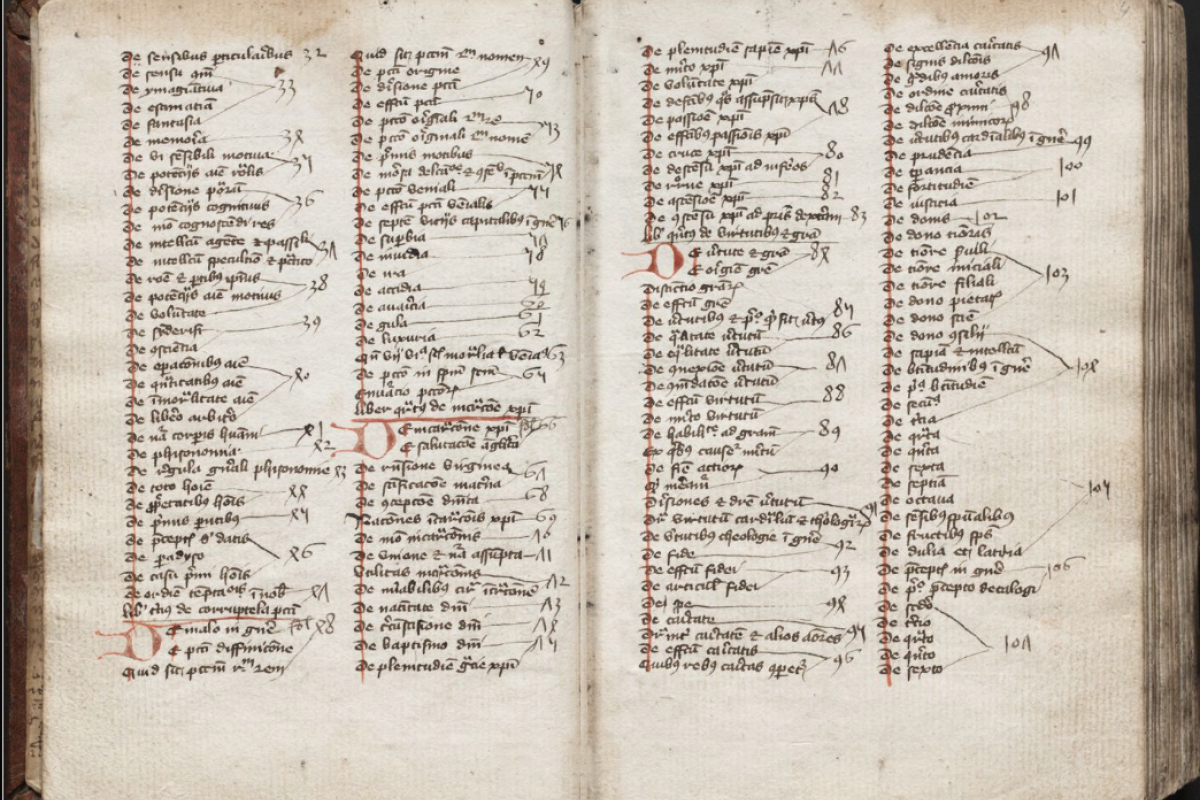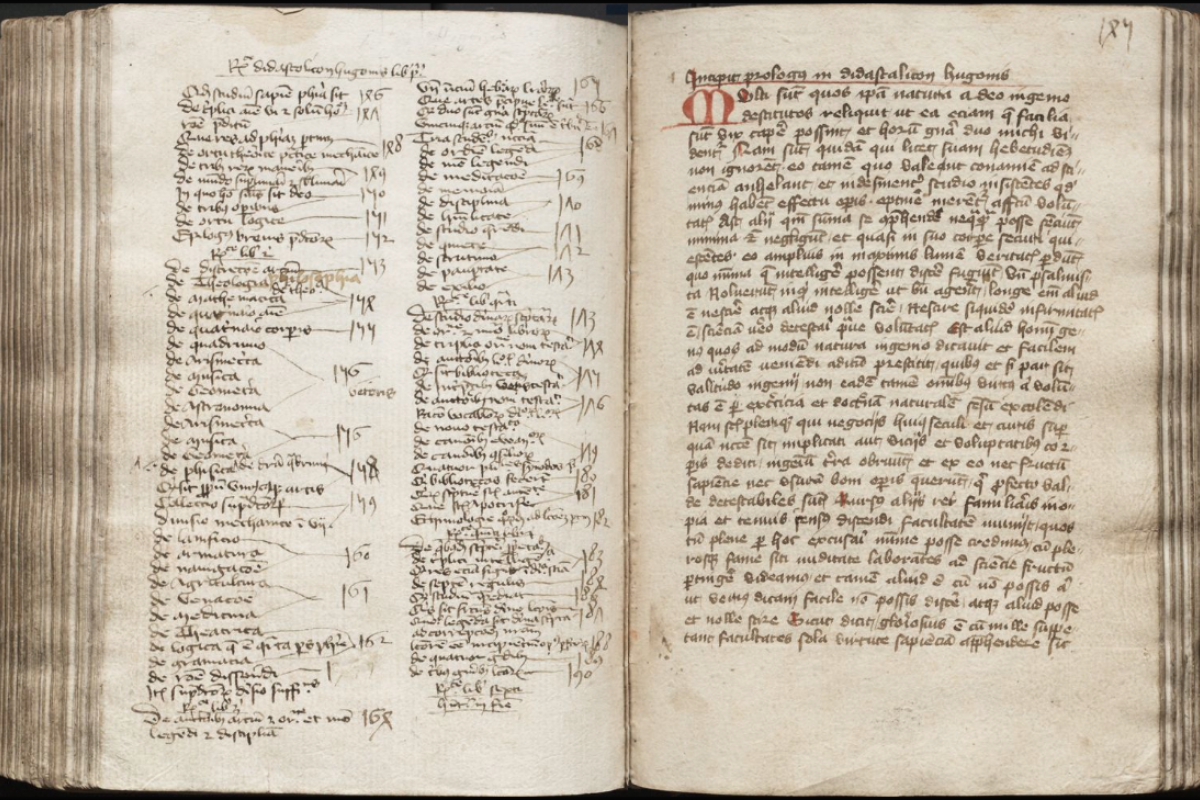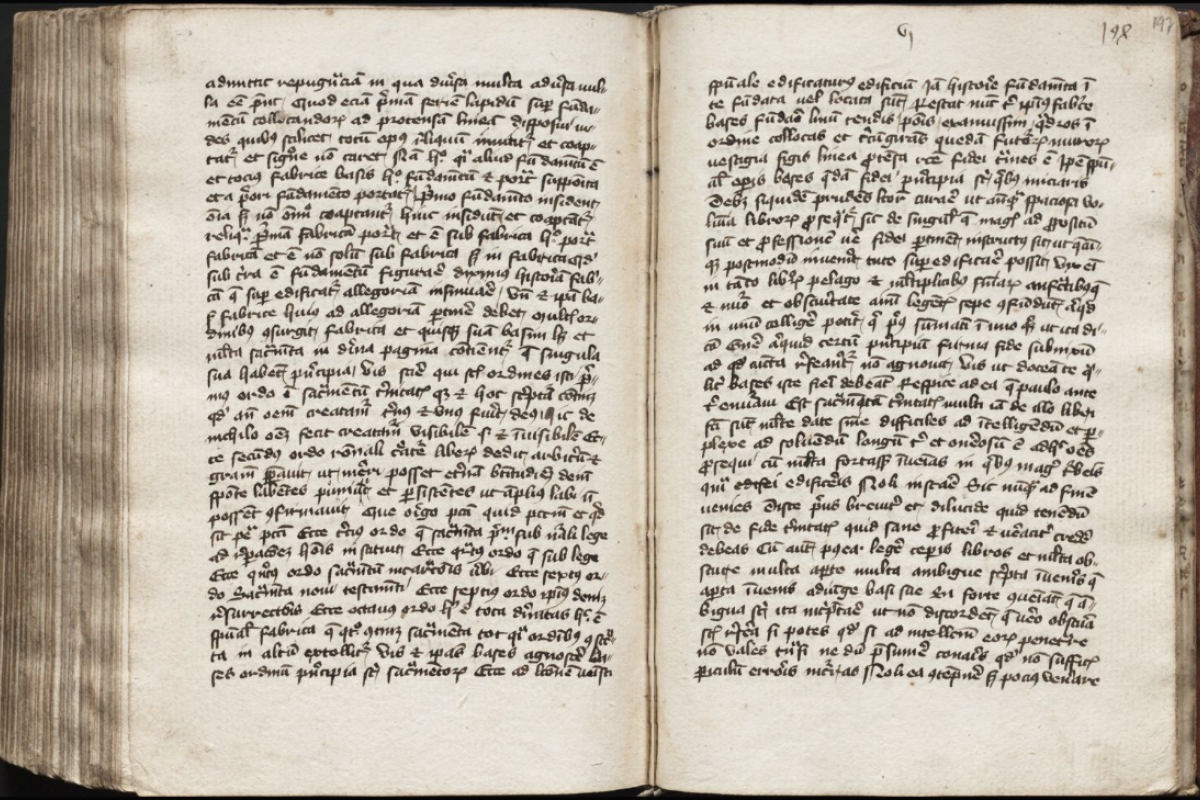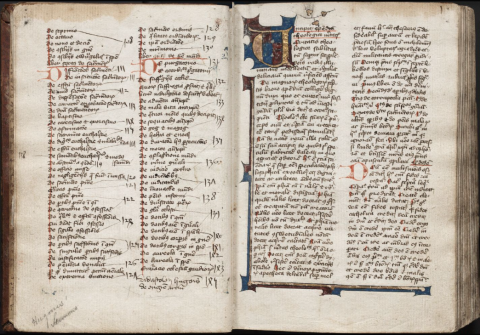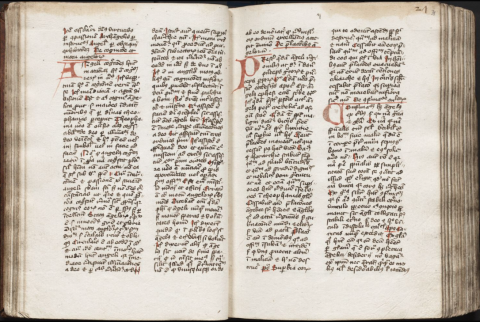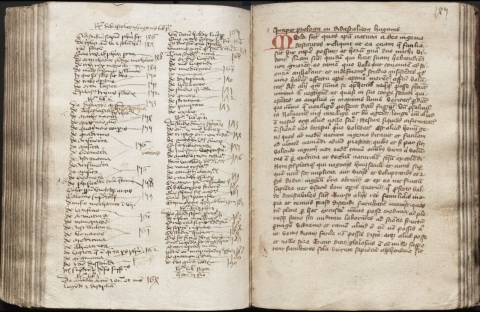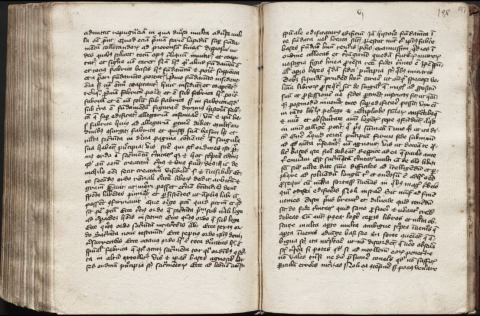Compendium Theologiae Veritatis of Hugo Ripelin Von Strassburg
Compendium Theologiae Veritatis of Hugo Ripelin Von Strassburg
German (Strassbourg?), 15th century
Language: Latin
vellum
height 14 cm
width 12 cm
University of Portland, Clark Library, Ms V C
April Perrine - Medieval Portland Capstone Student, 2008
The manuscript contains 209 folios on vellum. The first 144 folios contain the text for Hugo Ripelin Von Strassburg’s Compendium Theologiae Veritatis. It is written in two columns, each containing anywhere from twenty-eight to thirty lines of text. The first folio contains words written upside down, possibly printed or stamped. From 145 until folio 203 is the text of Hugh of Saint Victor’s Didiscalicon. It is written in block formation rather than two columns. Folios 208 and 209 contain an unidentified text that is used as flyleaves for the binding. The binding itself is calf on wooden boards, with clasps back to front that are missing. It was most likely written sometime in the early fifteenth century, and is possibly of German or French origin.
The first text of this manuscript is Hugo Ripelin von Strassburg’s Compendium. While it was written sometime during the last half of the thirteenth century, it was “one of the most widely-used handbooks of scholastic theology in the later Middle Ages” (Palmer 486). The text was erroneously attributed to several authors throughout its use over a span of 400 years, including Ripelin’s teacher, Albertus Magnus, and his contemporary, Thomas Aquinas. It is only in recent times that it has been attributed to Ripelin himself.
In a review for Georg Steer’s modern translation of the Compendium, it is noted that the medieval translations “have come to be seen as key witnesses of the role played by German scholasticism in the creation of a German philosophical vocabulary (Palmer 486). Steer’s conclusion is that these medieval translations were read by priests rather than illiterate laymen (487). Since education in Germany was mostly founded through ecclesiastics, this statement underscores the importance of this text in creating the medieval German university.
The second text in the manuscript is Hugh of St. Victor’s Didiscalicon, which was written sometime around 1125, most likely in Paris. This book “provided intellectual and practical orientation for students of varying ages and levels of attainment” (Taylor 3) for students entering his school at the Abbey of Saint Victor. This guide was “partly a history and reading guide...as a preliminary to theology..." (French 79). Like the Compendium, the Didiscalicon was meant to be a textbook and introductory guide to theology and philosophy. It was immensely successful throughout Europe in its own time, and influenced many later writers, including John of Salisbury and Thomas Aquinas (Leitch 201). Our manuscript, then, does appear to be a textbook in form, perhaps a primer or prerequisite before entering undergraduate studies.
Hugh’s account, unlike Ripelin's, was written before Aristotle’s texts had become widely translated into Latin. However, Hugh does make reference to him in his text. “Hugh gives no evidence of having known of the discovery of the new logic of Aristotle” yet his text is “Aristotelian in ultimate inspiration” (Taylor 6). Ripelin’s Compendium seems to follow Aristotelian thought as well. Some sources indicate he “followed Albert’s [Magnus] New-Platonic rather than Aristotelian interests,” but it is also important to note that his thoughts aligned closely with Aquinas’, who was Aristotelian himself (Mystics 4). Each tried to give a broad overview of theology and philosophy, and agreed that the purpose of seeking knowledge was to understand God better, and they did so through the Greek classics, most notably Aristotle. Thus, we see an underlying connective thread between each piece, despite the time and distance from each other.
It is important to note that Ripelin’s Compendium was more than likely attributed to someone else during the Middle Ages. Most often it was published under Albertus Magnus, Ripelin’s teacher. While the Germans “played a peripheral role in the history of medieval scholasticism…Albertus Magnus…stands out as the exception” (Overfield 4). A member of the Dominican friars, Albertus taught both Ripelin and Aquinas in Cologne. In 1248, he was named master at the new “studium generale” in Cologne, which was one of the schools of theology run by the Dominicans (Leitch 241). Thus, even when Ripelin’s work is not attributed to himself, its association with Magnus allows a strong possible connection with German scholasticism to continue.
Hugh of St. Victor’s connection is mostly with Paris, where he served as prior of the abbey at St. Victor’s from 1133 until his death in 1141 (Leitch 201). Although the school was already established by the time of his entrance, he was instrumental in restructuring and redefining its curriculum. However, Hugh himself was more than likely born and educated somewhere in Saxony, or in one of the Low Countries (what is now modern day Germany).
There are several other clues that indicate this manuscript is of possible German or French origin, and dates from the first three quarters of the fifteenth century. These clues pertain to the forms of the numerals that are written at the beginning of each text. The modern “2” we use today came into use in fourteenth century; prior to that it had no horizontal foot. The shape “Λ” was used to indicate the numeral “7” until the late fifteenth century (Thompson 92). Since there is no evidence of the modern day numeral “7” within this text, it becomes easier to establish this manuscript as belonging to an earlier period. The modern form of “2” is prevalent, so it helps to narrow the timeframe to somewhere between the fourteenth and fifteenth centuries.
The upright Italian form of “4” is documented in the early fourteenth century, but paleographer G.F. Hill notes that this is the exception rather than the rule, and “failed to find any instances until after 1400” (12). Since our manuscript does not contain any upright forms of “4,” it becomes easier to rule out Italian as a country of origin, and reinforce the dating of the manuscript to somewhere in the fifteenth century.
The form of the number “5” throughout the text also indicates a possible German origin: “The 7-shaped German form of “5” is well illustrated in [Mss: xv century German]” (Hill 13). The numerals within this table are from the fifteenth century, with the first half documenting this odd shape through 1470, but not thereafter. While Hill does concede that the numeral “5” is the “most freakish of all figures” and therefore is a “little untrustworthy” (12), he does take the time to point out that this particular shaping is a German form, and therefore unique to its area.
Regardless of origin, another interesting aspect of the handwriting is its liberal use of contractions and abbreviations. Accordingly, its presence indicates that this particular text was not meant for public viewing, but instead suggests a more private one: “With the introduction of minuscule writing for the book-hand, and if the manuscript were written for private use, there was more scope for this convenient system of saving labor and space” (Thompson 90). While this seems to contradict the idea that this manuscript is a textbook, we must remember that medieval textbooks were very different from our modern day form. It is possible that these two texts were written by two different persons, and then bound together in order to create a textbook that contains two similar theological foundations.
If this text is German in origin, and from the fifteenth century, then there is much to be said about it. During the late fifteenth century, there occurred a huge struggle over educational standards within the German universities. Known as the Wegestreit, there were two schools of thought on this subject, the “via moderna” and the “via antiqua”. These two groups had roots that can be placed within the fourteenth century, at a time when “prominent scholastics rejected the philosophical and theological doctrines of the great thirteenth-century masters- Albertus Magnus, Aquinas, Bonaventure, and Scotus” (Overfield 50). Remember that the Compendium was originally attributed to three of the four persons named above.
Those who believed in the “via moderna” form were followers of William of Ockham, and others like him. They tended to depart from Aristotle and his rationale; or at least from the eleventh and twelfth-century interpretations of his work. The rise of Humanism instigated a shift from education whose purpose was to know God to an education focused on Man. This shift would only complete itself at the rise of the Renaissance era, but its own foundation began with this initial shift.
This shift, while prevalent in many areas of Europe, seems to have been focused more sharply in Germany: “the ‘via moderna’ was a typical product of the fifteenth century, closely related to the proliferation of new universities in the German Empire” (Hoenen 12). Therefore, if this manuscript is indeed German in origin, and from the early fifteenth century, it would advocate a position within the “via antiqua” discipline of thought-a position that was rapidly disappearing at this time. This would make the manuscript appear to be an anomaly. However, there is one important statement that snaps our attention back to its original position:
Fifteenth Century theology was marked by an enormous desire to collect traditional opinions and bring them together within the framework of a commentary on the Sentences [of Peter Lombard] or some other systematic plan. The ideal was encyclopedic eclecticism. (Hoenen 19)
What this suggests is that our manuscript can be placed within an academic setting during the early fifteenth century, without having to make it an exception to the rule. While it may be of possible German or French origin, there is no evidence (yet) that this text was structured within the Wegestreit debate, or meant to be a statement in itself to that end. However, it does create a possibility for research within this area.
This also explains why these two texts would be placed together despite the gap between them. Hugh’s Didiscalicon was written in the 1120s prior to the emergence of the Latin translations of Aristotle’s works. Ripelin’s Compendium was written in sometime in the 1250s or 1260s, and was widely attributed to many other people. But both carry the same philosophical and theological foundations, and were used within an ecclesiastical educational structure.
Bibliography
French, Roger, Andrew Cunningham. Before Science: The Invention of the Friars’ Natural Philosophy. Brookfield: Scolar Press, 1996.
Hill, G.F. The Development of Arabic Numeral in Europe: Exhibited in sixty-four Tables. New York: Oxford Clarendon Press, 1915.
Hoenen, Maarten J.F.M. “Via Antiqua and Via Moderna in the Fifteenth Century: Doctrinal, Institutional, and Church Political Factors in the Wegestreit.” The Medieval Heritage in Early Modern Metaphysics and Modal Theory, 1400-1700. Ed. Russell L. Friedman and Lauge O. Nielsen. Dordrecht: Kluwer Academic Pusblisher, 2003. 9-36.
Leitch, Vincent B., ed. Introduction. “Thomas Aquinas.” The Norton Anthology of Theory and Criticism. New York: Norton and Company, 2001. 242.
Leitch, Vincent B., ed. Introduction. “Hugh of St. Victor.” The Norton Anthology of Theory and Criticism. New York: Norton and Company, 2001. 201-202.
Marenbon, John. Later Medieval Philosophy. New York: Routledge and Paul, 1987.
“Mystics (1300). Chapter Three: Community.” Dominican Central. 30 June 2008 <http://www.domcentral.org/study/Ashley/Dominicans/ashdom03.htm>.
Palmer, Nigel F. Rev. of Hugo Ripelin Von Strassburg: Zur Rezeptions- und Wirkungsgeschichte des ‘Compendium theologicae veritatis’ in deutschen spatmittelalter, by Georg Steer. The Modern Language Review 78 (1983): 486-487. 30 June 2008 <http://www.jstor.org/search>.
Overfield, James H. Humanism and Scholasticism in Late Medieval Germany. Princeton: Princeton University Press, 1984.
Taylor, Jerome. The Didiscalicon of Hugh of St. Victor: A Medieval Guide to the Arts. New York: Columbia University Press, 1961.
Thompson, Sir Edward Maunde. An Introduction to Greek and Latin Palaeography. New York: Burt Franklin, 1912.
Wilma Fitzgerald, PhD, SP - Quoted with permission from an unpublished study
Hugo Strassburg / Hugo Ripelin Argentinensis. Compendium theologiae veritatis. 2) Hugo de Sancto Victore. Didascalicon de studio legendi siue eruditionis didascalicad libri. 3) Unidentified legal text? on vellum fragments used as four fly leaves. Saec. XV ex. FF ii + 209 (paper) + ii , 140 x 120 mm., 35-38 lines. Didascalion of Hugo Strassburg. One column 28-30 lines. Initial in burnished gold on red, blue ground. End leaves 1-2, 208-209 [30 lines two columns] are from another manuscript. Two sets of numbering earliest began with 1 on what is now numbered 5. Index on f. 3-4v. Bound in calf on wooden boards, clasps back to front are missing. At bottom of first fly leaf upside down: In nomine tuo here in dijme vei bolghenheit non ita non apponat.
1) f. 1-144 (now 5-148) Hugo Ripelin Argentinensis / Hugo von Strassburg. Compendium theologiae veritatis.
Veritatis theologiae sublimitas eum superni sit dominis radius illuminans intellectum et .../... gaudia solio ad atque quodam ad corpus quodam ad quisquis beatus secundum merita recipiet sine fine amen. Explicit compendium theologiae veritatis. Edited in Albertus Magnus ... Opera 3, 201-234; 237-353 (Paris 1895)
2) f. 144v-203 (149-206) Hugo de Sancto Victore Didascalicon cum praefatio.
// [ Didascalicon de studio legendi / siue eruditionis didascalicae libri septem. Praef.] Multa sunt quos ipsa a deo natura ingenio destitutos reliquit ut ea etiam que facilia sunt intellectu uix capere possint et horum duo genera michi uidentur.../... aliter corpus enim propter paruitatem simplex dicitur est // See: PL 176. 828D-829A
3) f. i (1) // quibus quedam episcopus et quedam ... et quedam alius que uocabatur magister dati sunt iudices ei .../... delegati quia et si abstulisti maiestat uidex delegatus non sit [page stub]
f. ii (2) hoc ab alio culmine id optinere censemus ad idem extra de quibus cum spirituali .../... probetur tam principalis quam non placet rationem praemitta .../... Reus ad iudicium uocatur si non post iudicium declinare .../... sit ad exterpanda quoniam si//
f. iii (208) // uel ab agendo repellatur et ab morienda ... et non ordinetur et ipsis duabus.../... in modum exceptionis testes et // a testimonio //
f. iiii (209) //gauit iudicem se ... coram eodem iudice tamen in iuste suspitionis assignet et .../... posset declinare iudicis ... alle

